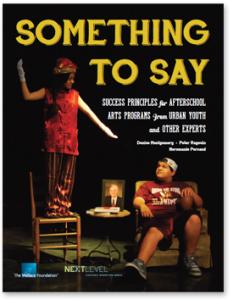
Author: Montgomery, Denise; Rogovin, Peter; and Persaud, Neromanie R.
Publication Year:
Media Type: Report
Summary:
Suppose afterschool arts programs tried a marketplace model to get more low-income, urban young people involved in the arts. That would make youngsters the programs’ “consumers” – with many options for their time and attention – and suggest the wisdom of finding out what these potential customers actually want.
A novel study, commissioned by The Wallace Founda-tion, adopted just such a market research approach. The team behind Something to Say: Success Principles for Af-terschool Arts Programs from Urban Youth and Other Experts interviewed more than 200 young people to see what inhibited them from taking part in afterschool arts programs, what would bring them in and what would keep them coming back. It then compared their views to the views of a group of leading arts program directors, re-searchers and other authorities on what constitutes effec-tive afterschool arts programming. Happily, the two sets of perspectives largely matched, with both kids and adults agreeing that afterschool arts programs should include real-world artists as teachers, hands-on projects, safe and inspiring spaces, and public events to showcase the work.
This Knowledge Breif accompanies the above report and an infographic.
Abstract:
Suppose afterschool arts programs tried a marketplace model to get more low-income, urban young people involved in the arts. That would make youngsters the programs’ “consumers” – with many options for their time and attention – and suggest the wisdom of finding out what these potential customers actually want.
A novel study, commissioned by The Wallace Founda-tion, adopted just such a market research approach. The team behind Something to Say: Success Principles for Af-terschool Arts Programs from Urban Youth and Other Experts interviewed more than 200 young people to see what inhibited them from taking part in afterschool arts programs, what would bring them in and what would keep them coming back. It then compared their views to the views of a group of leading arts program directors, re-searchers and other authorities on what constitutes effec-tive afterschool arts programming. Happily, the two sets of perspectives largely matched, with both kids and adults agreeing that afterschool arts programs should include real-world artists as teachers, hands-on projects, safe and inspiring spaces, and public events to showcase the work.
This Knowledge Breif accompanies the above report and an infographic.
Arts & Intersections:
Categories: Creative Youth Development, Arts Education
ADDITIONAL BIBLIOGRAPHICAL INFORMATION
PUBLISHER INFORMATION
Name: The Wallace Foundation
Website URL: http://www.wallacefoundation.org